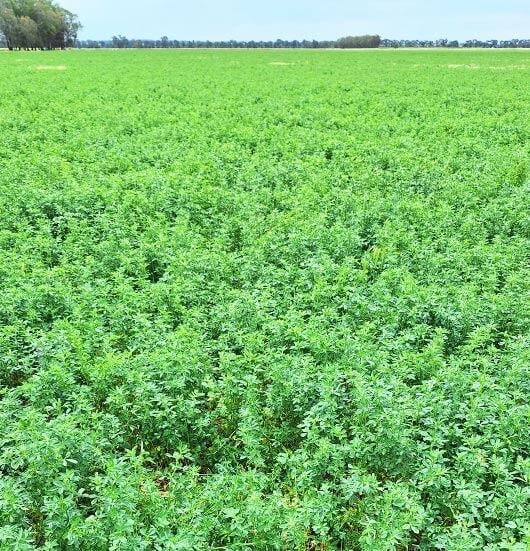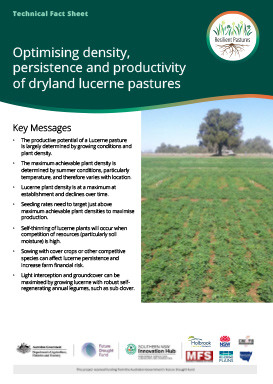Optimising density, persistence and productivity of dryland lucerne pastures

Publication date
30 Jun 2024
OPTIMISING DENSITY, PERSISTENCE AND PRODUCTIVITY OF DRYLAND LUCERNE PASTURES
Key messages
- The productive potential of a Lucerne pasture is largely determined by growing conditions and plant density
- The maximum achievable plant density is determined by summer conditions, particularly temperature, and therefore varies with location
- Lucerne plant density is at a maximum at establishment and declines over time
- Seeding rates need to target just above maximum achievable plant densities to maximise production
- Self-thinning of lucerne plants will occur when competition of resources (particularly soil moisture) is high
- Sowing with cover crops or other competitive species can affect lucerne persistence and increase farm financial risk
- Light interception and groundcover can be maximised by growing lucerne with robust self-regenerating annual legumes, such as sub clover.
Lucerne and drought resilience
Lucerne (Medicago sativa) is an important perennial pasture species in New South Wales. It can produce large volumes of high quality fodder for livestock and it grows in a range of rainfall zones. With its deep roots, it can build greater drought resilience into production systems by recovering rapidly and responding to out of season rainfall, lengthening feed availability throughout the year and providing the option of high quality fodder conservation. To achieve these outcomes however, it is important to maintain a viable population of plants within the pasture. That is, achieve optimal plant density at establishment and maximise ongoing lucerne persistence.
Plant density and persistence
Plant density refers to the number of plants per area, typically expressed as plants/m2.
Plant persistence refers to how well a plant species survives, measured by the change in plant density over time.
Lucerne density and persistence
Lucerne persistence is affected by rainfall and temperature over summer, grazing management and establishment density.
The maximum density of plants that can be sustained in a lucerne pasture is greatly determined by summer conditions for plant survival, particularly temperature. As these summer conditions vary with location, maximum achievable densities will also vary. Lucerne plant density is at a maximum at establishment and is known to decline over time. Lucerne, therefore, needs to be sown at a rate that achieves just above the maximum achievable plant density for that location. Seek local expertise may help to set target populations and sowing rates. For example, in the semi-arid areas of the Riverina and Central West NSW, a suggested target for dryland lucerne desnsity is 55 plants/m2 is needed to maximise lucerne production.
Sowing dryland lucerne at a maximum rate of 6 kg/ha bare seed may help achieve target densities of 55 plants/m2. While maintaining lucerne density at above 50 plants/m2 is possible, it is unlikely to be achieved in environments that experience hot summers. However, higher target densities would be required to maximise lucerne production under irrigation.
The impact of rainfall and temperature conditions over summer on lucerne persistence was demonstrated at research trial sites in Central west NSW. Six trials were established across three sites (Bogan Gate, Condobolin and Cowra) during 2013 and 2014. The trial’s main aim was to investigate lucerne persistence when sown with a cover crop, or under different row configurations.
In these trials, lucerne density declined after three years, except at sites that received over 100 mm of summer rain and cooler summer temperatures. This could also be calculated as greater than 2160 cumulative day degrees for the period between December–February (Hayes et al. 2021). Above this threshold, plant persistence declines.
What are day degrees?
Day degrees, also known as thermal time, combines time and temperature into a single unit.
Day degrees = average temperature recorded during a day.
Day degrees = (max daily temp + min daily temp) ÷2
Cumulative day degrees = the sum of day degrees over a specified time.
Is lucerne persistence affected when lucerne is grown with a cover crop?
Averaged across all the Central West NSW trial sites, the presence of a cover crop, including wheat, barley, canola or lupins during the first year of growth decreased lucerne density by 39 percent. Sowing lucerne and the cover crop in alternate rows, rather than mixing together in the same drill row, provided no advantage for lucerne density or persistence. Previous research has demonstrated that for enterprises running high stocking rates, establishing lucerne pastures on their own reduces farm financial risk compared to sowing lucerne under a cover crop (Nordblom et al. 2017).
Does growing lucerne with phalaris or sub clover, and in different row configurations, affect lucerne persistence?
Lucerne persistence and productivity was investigated across three sites established in the NSW Riverina at Eurongilly, Mirrool and Wagga Wagga during 2012. Various combinations of lucerne, phalaris and sub clover were sown together in mixed drill rows or separated in every second (1:1) or every third (1:2) row configurations, using 25 cm row spacings.
The same quantity of seed was sown per square metre across all row configurations; a similar lucerne establishment density of approximately 55 plants/m2 was achieved, regardless of row configuration. This was found to be the maximum practical density that could be achieved across the sites.
Lucerne density declined after three years in all treatments, with the rate of decline governed by summer conditions at each site. Where lucerne was sown in every row, every second row, or every third row, the density of around 55 plants/m2 equated to 14, 28 and 37 lucerne plants per metre drill row respectively. Figure 2 shows the different lucerne densities per metre of drill row at the Eurongilly site during July 2014. The greatest density decline occurred where lucerne was sown once in every third row. In this treatment, greater competition for resources between lucerne plants restricted tap root diameter, and after two years lucerne density had decreased to approximately 30 plants/m2, compared to other treatments which decreased to approximately 40 plants/m2. This indicates establishing lucerne at above 28 plants per metre drill row restricts long term persistence.
Plants per metre drill row
Plants per metre drill row indicates how close plants are to each other within the drill rows.
Lucerne tap root diameter was restricted when the number of plants per metre drill row exceeded 28 in the Riverina experiments.
The importance of maximising groundcover
Ground cover is important for maintaining soil moisture through decreased soil water evaporation, and by providing protection against erosion. Achieving the highest maintainable lucerne density is important for maximising resources, such as sunlight and rainfall, which in turn maximises pasture production and ground cover.
In the Riverina experiments, ground cover was greater where lucerne was sown with other pasture species compared to where lucerne was sown alone. This shows that sowing lucerne in a mix with other pasture species can increase ground cover and maximise the use of sunlight, rain and nutrients to boost pasture production.
Self-regenerating annual legumes as companion species
When determining the compatibility of pasture species in a mix, it’s important to consider how individual species compete for resources, such as water, sunlight and nutrients, as well as their ease of management in terms of grazing and weed control.
Lucerne is most active from spring through to autumn and the most suitable type of companion species for lucerne may be self-regenerating annual legumes. These species avoid the effects of dry conditions over summer as they seed and regenerate when conditions are favourable.
Summer-active species, such as chicory or tropical grasses, compete strongly with lucerne for resources over summer. This means they can limit persistence, so should be avoided as a companion species.
Other winter-growing perennial species, such as strawberry clover, may also be suitable companions for lucerne, but it’s important to remember that perennials need to persist through summer. Lucerne’s summer activity makes it a strong
competitor for available soil moisture and other resources, which can increase the pressure on other perennials and potentially hinder their survival over summer.
Table 1 lists pasture species that may be suitable to grow with lucerne, however, suitability depends on regional conditions and management.
Table 1: Suitable companion species for sowing alongside lucerne
| Species | Positives | Negatives |
| Sub clover |
|
|
| Arrowleaf clover |
|
|
| Biserrula |
|
|
| Yellow serradella |
|
|
Ideal characteristics of pasture seed in central and southern NSW
Hard-seeded: “Hard-seededness” is an important seed dormancy mechanism in annual pasture legumes. Hard seeds are less prone to germinating prematurely after summer rains or false autumn breaks, due to their impermeable seed coat. Consequently, hard-seeded varieties can maintain good seed banks despite repeated dry periods.
Small seeded: Small seed size means a greater number of seed per kilogram. Under dry spring conditions, where seed production is constrained, smaller seeded species can set a greater number of seeds compared to larger-seeded species. This is
likely to improve legume regeneration in later years.
Tips when sowing lucerne
- Sowing rates for dryland lucerne in most semi-arid (cropping zone) environments of South East Australia should target an initial lucerne density of 30–60 plants/m2, with drier sites targeting the lower end of the range. These densities will still be slightly above the density that can be maintained in most summers, but provide opportunity to maximise production in the event of favourable summer conditions early in the life of the stand. This may equate to 3–6 kg/ha bare (not coated) lucerne seed.
- Sow lucerne at the narrowest row spacing possible to maximise early pasture production and ground cover.
- Sow lucerne into standing stubble to utilise ground cover which can minimise water loss via evaporation, and lead to better utilisation of summer rains.
- Sow lucerne with well-adapted winter growing, small and hard-seeded companion legumes, or consider establishing a residual seed bank of these companion legumes prior to establishing lucerne.
Acknowledgements:
Creating Landscape-scale Change through Drought Resilient Pasture Systems, otherwise known as ‘FDF Resilient Pastures’ is a project funded by the Australian Government’s Future Drought Fund Drought Resilient Soils and Landscapes Grants Program, secured by Southern NSW Drought Resilience Adoption and Innovation Hub. The project is led by Holbrook Landcare Network and partners include Central West farming Systems, Monaro Farming Systems, Riverine Plains, FarmLink, Local Land Services, NSW DPI, CSU and The Southern NSW Resilience, Adoption and Innovation Hub, with a project period of June 2022 – June 2024.
NEWS
Discover unique perspectives on agriculture from across the Riverine Plains.
-
Livestock
-
People
-
Grains
-
Sustainability

